Why Learner-Centered Education is the Key to Meaningful School Improvement

Effective educators have long known that one-size-fits all approaches to teaching and learning are insufficient. Through extraordinary effort, they have figured out ways to differentiate and personalize learning for their students. They have done so despite an industrial-era education paradigm that makes it very difficult to do so. Over time, some of their efforts were named, systematized, and scaled.
Today, building on these approaches, some believe (count us among them) that a shift to an entirely new education paradigm is within reach. Harnessing new technologies, aided by advancements in transportation and communication, and required in order to adequately respond to deep and disruptive social, economic, environmental, and political forces, we envision a fundamental shift in how learners experience their education. Specifically, we envision moving from a school-centric, industrial-age model akin to factories and assembly lines, to a learner-centric, networked-age model characterized by lateral connections and flexibility. In short, we envision learner-centered education.
But what does the movement towards learner-centered education mean for the many methods for designing learning and differentiating support to students developed in recent decades?
In this piece, we identify some of the most-broadly adopted methods developed by educators to differentiate support, improve learning design, and meet the individual needs of learners. They include Response to Intervention (RTI), Positive-Behavior Intervention Systems (PBIS), Universal Design for Learning (UDL), and Multi-Tiered System of Support (MTSS). Then, we seek to compare learner-centered education to these approaches, exploring the implications for each. Ultimately, we will make the following arguments:
- Learner-centered education is about a paradigm shift, not a specific methodology.
- Learner-centered education requires learning design that is flexible and adaptive, similar to or expanding upon the principles of UDL.
- Learner-centered education may include specific methodologies for differentiating support (e.g. RtI or PBIS), but it is more likely to extend and/or replace them.
- Learner-centered education is additive to and inherently strengthens existing systems-level approaches such as MTSS.
- Learner-centered education is fundamentally adaptive and outcomes-focused (rather than technical and process-focused).
All of the approaches we name above recognize the same problem. The current industrial model for teaching and learning was designed based on an assembly line metaphor, expecting students to move through school in the same amount of time with more or less the same amount of support regardless of where they enter, unique challenges they may be facing, or strengths they may bring.
Within this rigid system, educators have sought ways to differentiate support. Over time, some of the techniques educators developed to provide each student the support they need have been built upon to create school and systems-level approaches. Tiered systems of support and intervention such as Response to Intervention (RtI) and Positive Behavioral Interventions and Supports (PBIS) were developed to introduce achievable levels of differentiated support (e.g. 3 tiers) within the constraints of the industrial paradigm.
- Response to Intervention is a multi-tier approach and framework for instruction that screens all students for learning needs, and then provides progressive levels of intervention to students on an as needed basis. Interventions scale-up in the level of intensity such as supplemental instruction within the large group (typically Tier 1), targeted small group instruction (Tier 2), and individualized, intensive instruction aimed at skill deficits (Tier 3), though tier definitions and strategies differ by school. In practice, RtI models may call for individualized interventions (problem-solving models) or preselected interventions (standard protocol models). The three essential components are tired instruction and intervention, ongoing student assessment, and family involvement. RtI originated from the goal of proactively identifying and providing special education interventions to students before they fall too far behind.
- Positive Behavioral Interventions and Supports is also a three-tier approach and framework but focused on student behavior and social-emotional development. The goal of PBIS is to proactively promote positive behavior. Similar to RtI, PBIS typically scales interventions starting with universal and proactive routines and support provided to the full classroom or school (Tier 1), then targeted behavior support (Tier 2), and lastly individualized, intensive support (Tier 3).
Recent innovations with tiered systems of support by organizations such as Turnaround for Children expand these models to include an understanding of trauma and adversity as well as taking into account how to adjust for hybrid and remote learning options.
These systems were developed based on a recognition that all students are capable of reaching similar outcomes, but require different amounts of time and support to get there. They were helpful steps towards providing each student with different amounts of time, support, and attention based on their needs. They have positively impacted tens of thousands of students in achieving desired standards however this often comes at the cost of removing students from their peers and narrowing the curriculum and will continue in such a manner as long as the traditional paradigm exists.
At the same time that these methodologies proliferated for differentiating and targeting support by pulling students out, complementary methodologies were developed for designing learning in a way that was flexible enough to meet the needs of learners with different motivations, interests, (dis)abilities, and needs. One example is Universal Design for Learning (UDL). UDL is an approach and framework for designing instruction and learning environments that are accessible to all students. UDL emphasizes providing flexibility in how students access content (e.g., visual, audio, hands-on) engage with it, and demonstrate knowledge or mastery. The goal is to remove barriers to learning. UDL is rooted in the premise that while accommodations and flexibility are necessary to ensure learning accessibility for some individuals, they in fact benefit all individuals (sometimes in unforeseen ways) and therefore should always be in play.
More recently, attempts have been made to create overarching systems that build on and integrate these into an overall coherent framework for systems change. One example that has gained widespread interest and adoption is Multi-Tiered System of Support (MTSS). MTSS is a framework for meeting the academic, social, and emotional needs of students. It builds upon and may include data-driven, tiered intervention strategies such as RtI and PBIS as part of the approach. However whereas RtI primarily focuses on academic learning and PBIS focuses on behavior and social/emotional development, MTSS aims to bring a more comprehensive lens and integrated approach to meeting the needs of learners. Moreover, MTSS is often described as a system-level approach with implications for aligned leadership, resource allocation, professional development and more.
This now brings us to the term that is at the center of our inquiry: learner-centered education. Like MTSS, learner-centered education has been growing in popularity. Learner-centered attempts to define an alternative to the industrial-era education model itself. The graphic below, borrowed from Education Reimagined, makes this clear.
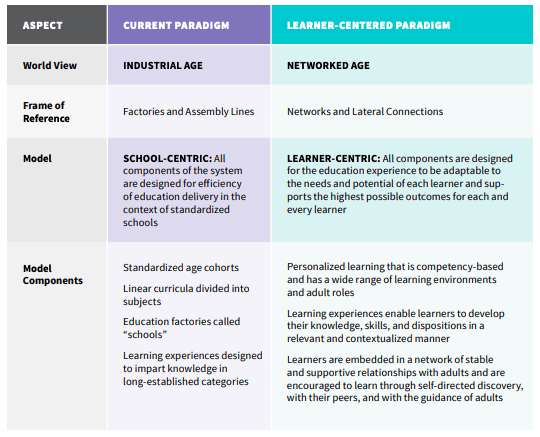
Learner-centered education is about a paradigm shift, not a specific intervention methodology. It pushes education leaders to critically consider the purpose of school and to re-envision how the complete education ecosystem prepares students for the future. Learner-centered education demands that we move away from the traditional industrial model towards a transformative one that designs learning in response to the diverse needs of students. This future-oriented paradigm requires a new set of student outcomes and aligned success metrics as part of its vision, whereas most of the above can function within the traditional set of outcome metrics. Lastly, learner-centered education goes beyond schools as the unit of change. Instead, it looks at the needs and goals of the individual learner and macroscopically at opportunities for learning within an education ecosystem.
An example of a learner-centered student outcomes framework:
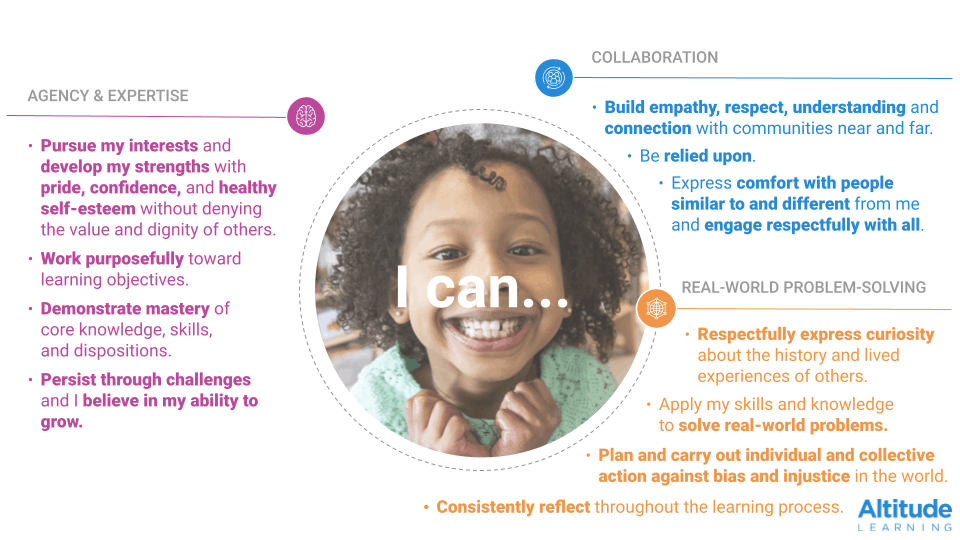
Because learner-centered education is referencing an alternative paradigm, rather than a specific methodology, it is compatible with the previously referenced strategies to varying degrees.
Learner-centered education is compatible with the implementation of a learning design that is flexible and adaptive, similar to or expanding upon the principles of UDL. Because humans naturally learn, process, and express themselves in different ways, UDL rightly emphasizes the need to incorporate flexibility into (1) how learning content is represented for accessibility; (2) how students are motivated to engage in the learning process; and (3) how understanding or skill mastery can be demonstrated. This type of learning design should be pursued within a system that is learner-centered, in a way that increases learner agency, is personalized, relevant, and contextualized, socially embedded, and extends beyond the walls of the school. The chart below shows how learner-centered and UDL are not only compatible but additive.
UDL + Learner Centered Education
Learner-centered education may include specific methodologies for differentiating support (e.g. RtI or PBIS), but it is more likely to extend and/or replace them. Because a learner-centered system typically has a competency-based progression (as compared to seat time and lock-step progression), individual goal-setting elements, and a heavy emphasis on student agency, it is more flexible and aggressive in creating personalized learning experiences than existing tiered intervention models such as RtI or PBIS. Additionally, RtI and PBIS largely operate as a safety net and focus on providing targeted interventions to lower-performing students. As part of its paradigm shift, learner-centered education shifts the concept of “intervention” to be less about addressing deficits for lower-performing students and more about providing individualized support, guidance, and agency to all students.
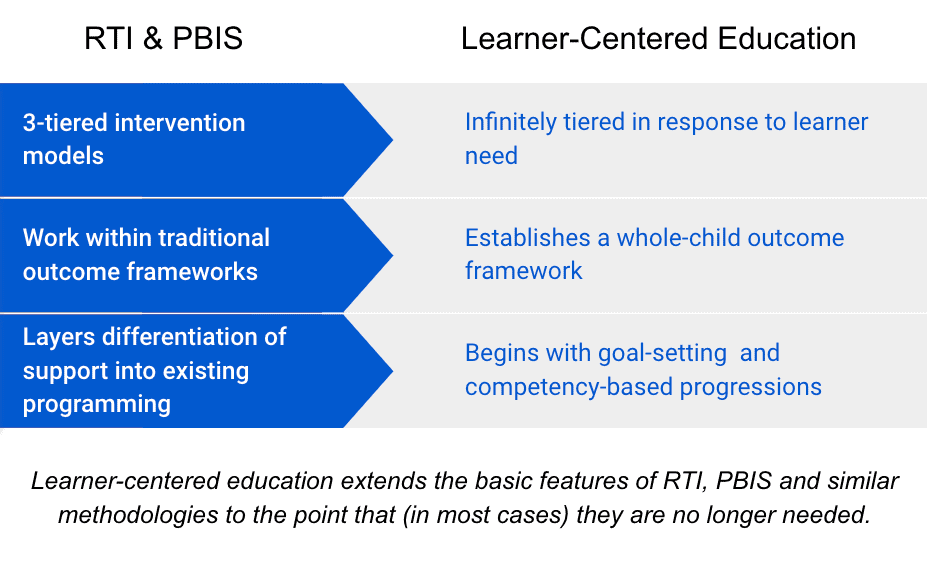
Learner-centered education is additive to and inherently strengthens existing systems-level “solutions” such as MTSS. MTSS is a methodical framework for guiding school- and system-level action so that everyone is rowing in the same direction. It is a tool for systems-level change, and it is a useful framework for aligning tiered support with UDL, along with an emphasis on education equity. That being said, it is also process-oriented and can be effectively used in the traditional paradigm OR in a learner-centered paradigm. In other words, MTSS can be used to nurture learner-centered education IF it is oriented around such a vision and includes the appropriate supports and practices.
Learner-centered education is fundamentally adaptive and outcomes-focused (rather than technical and process-focused). It is for this reason that learner-centered education is complementary to all of the aforementioned methodologies, and, further, can actually serve as an overarching vision and educational philosophy that encompasses and leverages the best of them in combination. Learner-centered education challenges educators to consider what school is all about, and what outcomes should serve as the north star. Instead of taking a school-centric approach to education, learner-centered education calls on schools to co-design (with learners) flexible learning experiences that meet the unique needs and tap into the unique motivations of individual students.
In conclusion, RtI, PBIS, UDL, and MTSS are important innovations that continue to have a place in schools today. These methodologies provide useful structures that enable educators to implement evidence-based practices, assess and respond to student needs, and create accessibility and equity throughout the system. That being said, alone they are insufficient for achieving the transformative changes needed in schools around the nation. Learner-centered leadership is needed to extend these systems to focus less on standardization and the needs of the schools, and more fully on the needs of every child.
In doing so, we must be careful to maintain learner-centered education’s positioning as a paradigm, and not as a methodology. There are likely many ways to realize it, and no one has the one right answer, hence its adaptive nature. In our effort to define learner-centered, and clarify what it is and isn’t, we should be careful not to lose this important characteristic.
For more, see:
- A Reliable Hybrid Learning Model: Cedar Rapids Schools Responds to Setbacks
- It’s Time to Reimagine Our Accountability Systems
This post includes mentions of a Getting Smart partner. For a full list of partners, affiliate organizations, and all other disclosures please see our Partner page.
Stay in-the-know with innovations in learning by signing up for the weekly Smart Update.




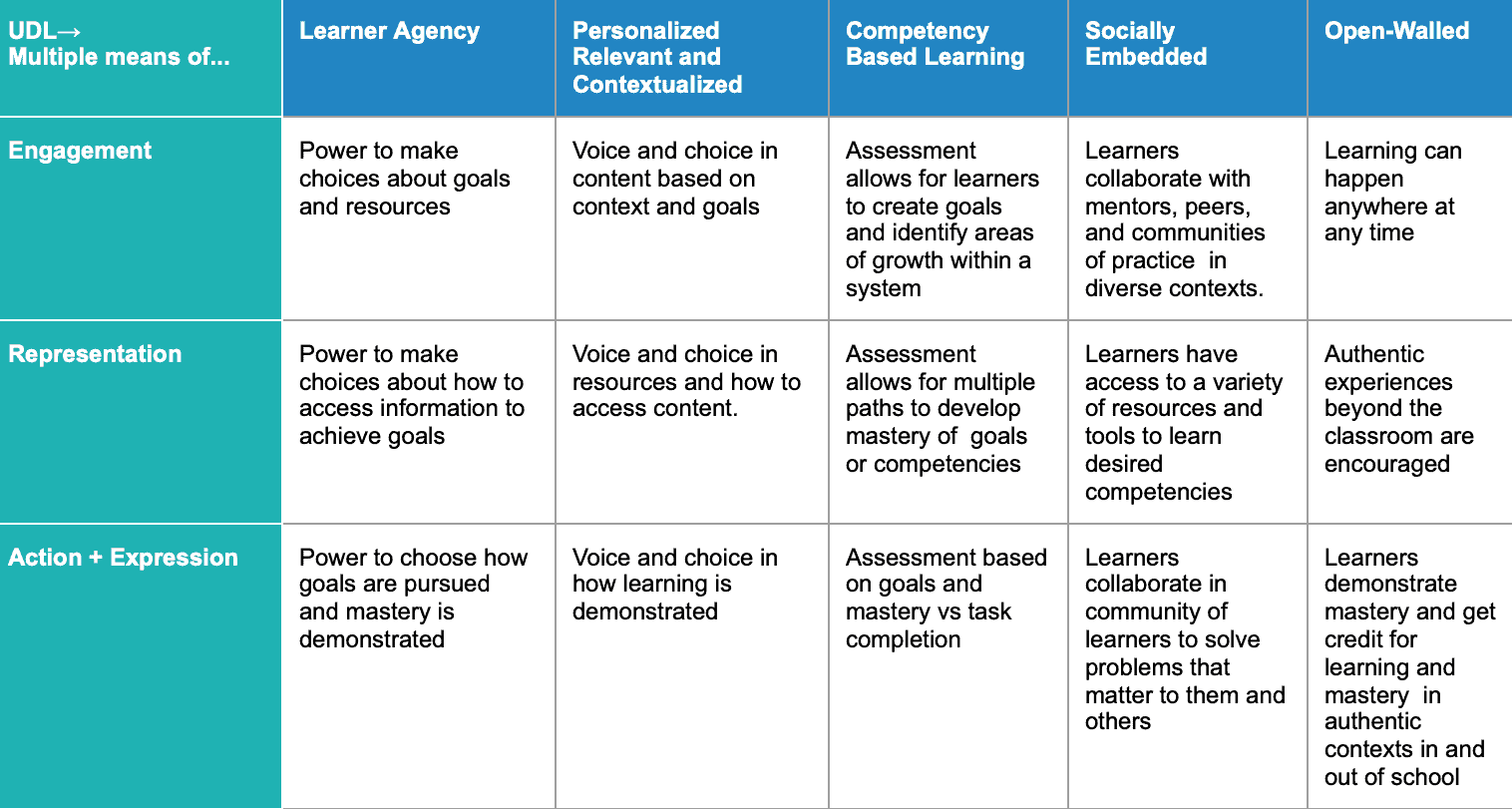



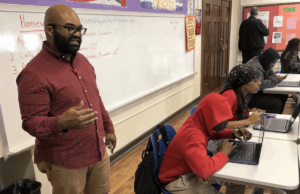
0 Comments
Leave a Comment
Your email address will not be published. All fields are required.